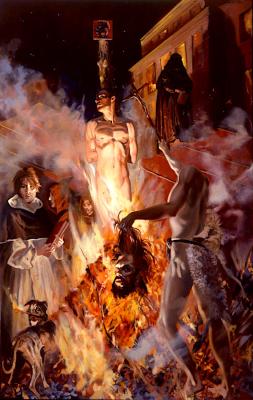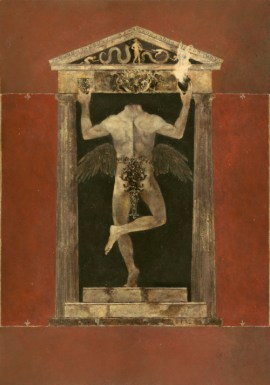Born in 1870, Alexander Rothaug was an Austrian painter, stage designer, and illustrator. He was active in Munich and his native Vienna during the end of the nineteenth- century and the first half of the twentieth.  After his initial painting lessons with his father, Rothaug took the position of apprentice in 1884 with sculptor Johann Schindler.
After his initial painting lessons with his father, Rothaug took the position of apprentice in 1884 with sculptor Johann Schindler.
Between 1885 and 1892, Alexander Rothaug received his training at the Vienna Academy of Fine Arts primarily under Leopold Carl Müller, a painter who displayed his colorist talent to great advantage in Oriental subjects. At the academy, Rothaug also received lessons from genre and landscape painter Franz Rumpler and painter Christian Griepenkerl whose speciality was portraiture and allegorical work drawn from classical mythology. For his academic work, Rothaug was awarded the Lampi Prize in 1888, the Golden Füger Medal in 1889 and, for work during Müller’s historical painting school, the 1890 Special School Award.
After graduation, Rothaug relocated to Munich where he attended its Academy of Fine Arts. He took a position for several years as an illustrator for the satirical journal Fliegende Blätter (Flying Leafs). In 1896, Rothaug married Ottilie Lauterkorn and, a year later, returned to Vienna as a freelance painter. Based on his experience as a stage painter,  Rothaug created monumental paintings for theater buildings, ceiling paintings, and a series of large wall-mounted paintings, scenes from Wagner’s “Ring Cycle”, for the Grand Hotel de l’Europe in the spa town of Bad Gastein, Salzburg.
Rothaug created monumental paintings for theater buildings, ceiling paintings, and a series of large wall-mounted paintings, scenes from Wagner’s “Ring Cycle”, for the Grand Hotel de l’Europe in the spa town of Bad Gastein, Salzburg.
Following a period of study trips to Dalmatia, Bosnia, Spain, Italy and Germany, Alexander Rothaug returned Vienna and became a member of the Vienna Künstlerhaus, an association representing Viennese painters, sculptors and architects. In 1911, an extensive article on Alexander Rothaug and his work was published in the journal Art Revue; two years later, he received the Drasche Award. Alexander Rothaug died in Vienna in 1946.
Rothaug had a lifelong interest in the depiction of ancient Roman, Greek, Germanic and Norse mythologies. His work blended the Classicism of Vienna’s Academic School with elements of Jugendstil, the German counterpart of Art Nouveau, and the mystic and nostalgic Symbolism of Franz von Stuck, a co-founder of the Munich Secession whose subject matter was primarily drawn from mythology.
von Stuck, a co-founder of the Munich Secession whose subject matter was primarily drawn from mythology.
As it is not signed, “The Death of Achilles” could be a preparatory work for a commissioned monumental painting. As the underdrawing can be seen in some areas, Rothaug was likely still working out the specifics of the composition. “The Death of Achilles” may have been part of a larger cycle of images, one either depicting the life of Achilles or events from the Trojan War. Rothaug paid particular attention in all of his works to the complex, carefully detailed musculature of the figures; he had previously published a treatise on the depiction of the human body titled “Statics and Dynamics of the Human Body” in 1933.
Note: In April of 2017, the online Renegade Tribune posted an article written by J. Belenger, entitled “The Mythological Art of Alexander Rothaug”, which contains a biography and fifty images of Rothaug’s work. This article can be found at: http://www.renegadetribune.com/mythological-art-alexander-rothaug/
Top Insert Image: Alexander Rothaug, “The Grim Garden”, 1930, Oil on Canvas
Second Insert Image: Alexander Rothaug, “Apollo Sending Out the Plague of Arrows”, circa 1920, Oil on Canvas, 185 x 236 cm, Belvedere Museum, Vienna
Bottom Insert Image: Alexander Rothaug, “Samson’s Revenge”, 1928, Oil on Canvas, Private Collection












































































